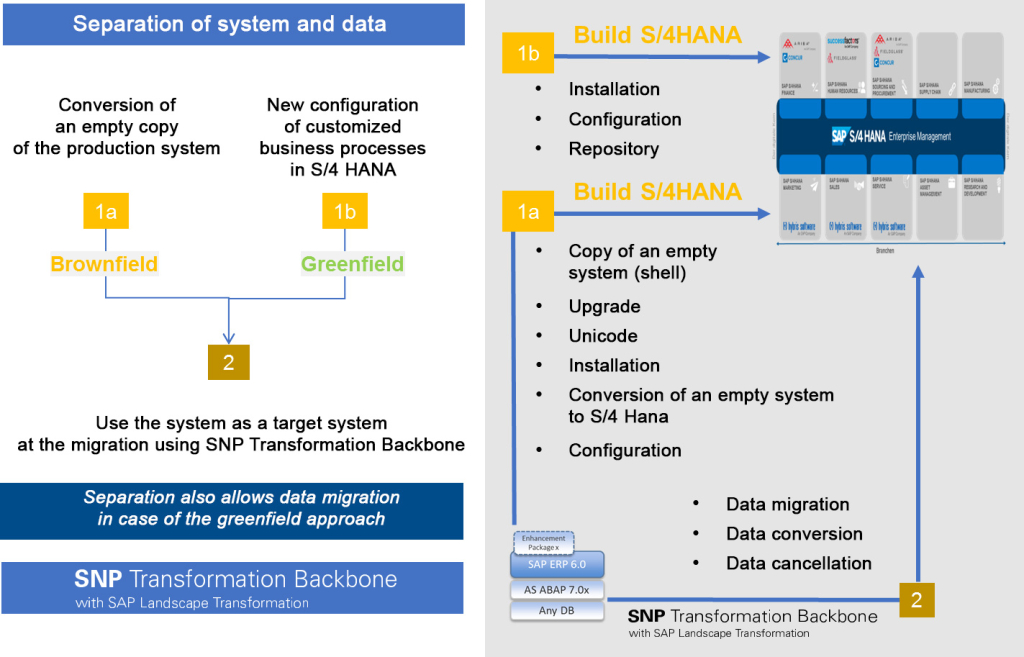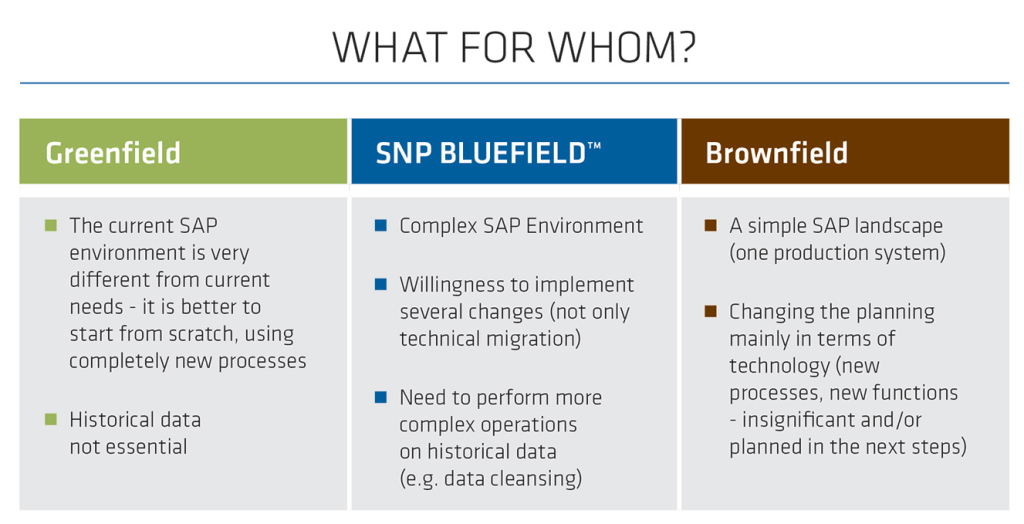The terms Greenfield and Brownfield are used in a variety of industries, meaning two main alternatives: a project carried out “from scratch” and a project using existing resources. In the context of S/4HANA migration, there is still a third, innovative approach developed by SNP: BLUEFIELD™.
Greenfield: start from scratch
Greenfield is de facto the implementation of the S/4HANA system from scratch. This perspective is particularly tempting when the existing SAP environment does not meet the real needs of the company regarding not only technology, but first of all, business aspects. Just like with an old house, in many cases it is better to demolish it and to design and build a completely new one instead of carrying out a complete renovation.
The new system is configured using the best SAP practices, taking into account the existing processes in the old SAP system (manually copied and customized configuration from the SAP ERP system). In addition, new settings for new processes/modules in S/4HANA are configured in it. In the case of greenfield, it is possible to partially migrate data from the legacy system, usually without transferring historical data (only balances and open items).
Advantages of this approach:
- Full utilization of S/4HANA innovations – we compose the needed set of functionalities from scratch based on real and current needs
- Opportunity to get rid of unused data (old company codes, old processes, old data)
- Possibility of redesigning and improving processes without limitation in the form of existing solutions
There are also disadvantages of the greenfield approach:
- Implementation from scratch takes time and is expensive
- It is not easy to change the whole ERP system (usually connected to multiple external systems)
- Not all historical data can be migrated to the new system
- Users have to learn how to handle new processes – everything is new
Brownfield: as an upgrade
The brownfield approach assumes basing on SAP functions used so far. Migration to S/4HANA is treated primarily as a technological change, just as previously the SAP ERP upgrade from 4.6 to ECC 6.0. Brownfield means that any other changes, such as the implementation of new large SAP functions or, for example, the implementation of the new general ledger functionality, will be covered by a separate project, after the completion of the “upgrade to S/4HANA”.
The conversion of an existing system to S/4HANA means keeping most of the current configuration and only adjusting some of its elements to the requirements of S/4HANA (new modules, new requirements, e.g. Business Partner). In such a project, the data from the source system, including historical data, is almost entirely preserved.
As regards methodology, the conversion to S/4HANA conducted in this manner is fully supported by SAP Solution Manager.
Advantages of the brownfield approach:
- A relatively fast conversion to S/4HANA
- Keeping most of settings and interfaces used so far
- Introduction of only minor changes for business users
Disadvantages are related to the fact that:
- no new S/4HANA capabilities are used. Although a new system is available, business processes are mostly carried out as so far
- implementation of new components is necessary where in S/4HANA the old components can no longer be used (e.g. an old treasury module in the finance area)
- despite the developed conversion procedure, the project is not short (takes from several months to even half a year).
BLUEFIELD™: several transformations in one step
Is it possible to combine the advantages of greenfield and brownfield approaches? What to do to obtain more flexibility offered by the greenfield approach, while preserving the simplicity of the project, historical data and the minimal downtime of the existing SAP system provided by the brownfield approach? Although it seems to be a combination of water and fire, it is possible.
The solution is the original SNP approach using well-proven SNP and SAP transformation tools (SNP Transformation Backbone with SAP LT) – SNP BLUEFIELD™.
SNP BLUEFIELD™ allows you to make several technological and business changes in one step (not only conversion to S/4, but also, for example, consolidation of several systems into one, and migration to the cloud). The migration project is implemented in a relatively short time and with the minimum downtime of systems (a near zero downtime (NZD) approach is possible). This is made possible by BLT solutions that automate data migration and testing of functions and processes. SNP solutions have been available as part of the CrystalBridge platform since 2019.
In methodological terms, the SNP BLUEFIELD™ approach consists in separating the conversion of an empty copy of the production system (without transactional data, brownfield) from the transfer of data to this system. Similarly to the new S/4HANA system (greenfield), historical data can be transferred with transformation tools using pre-defined transformations. So we can say that SNP BLUEFIELD™ includes and improves both previous approaches.
The separation of data transfer and use of SNP BLT transformation tools for data migration enable the transferred data to be cleaned and harmonized, while providing greater flexibility in terms of system changes compared to the brownfield approach.

SNP BLUEFIELD™ combines the ability to preserve historical data (characteristic of brownfield conversion) with the flexibility of data cleaning and harmonizing (characteristic of the new greenfield implementation).
In the SNP BLUEFIELD™ project, it is easy to select data that will not be migrated (e.g. company codes, plants not used any more). It is also easy to harmonize migrated data. It is possible, for example, to adjust the chart of accounts, profit centers or to change the identifiers of vendors and customers during the import for the purposes of implementing the central Business Partner in SAP. It is easy to provide the missing information in the data and to simultaneously implement e.g. a solution for splitting postings into multiple parallel books.
The separation of data migration from system conversion also allows the reduction of system downtime during the project. This is possible because the arduous conversion of an empty system can be carried out in parallel with the normal SAP system operation. System downtime is required only at the data migration stage at the database level.
To sum up, the advantages of SNP BLUEFIELD™ include also:
- Possibility of changing the landscape of systems in one project, while migrating to S/4HANA (e.g. migration from four SAP ERP systems to one S/4HANA system, or migration to the cloud)
- Possibility of cleaning and adapting data during its transfer (e.g. removal of unwanted data from the system, adjustment of historical data, harmonization of data)
- Possibility of making additional changes in the system in one migration step (single downtime, e.g. renumbering counterparties for the purposes of introducing BP/CVI, implementing the split payment in the new general ledger, etc.)
- One downtime for many changes, reduced to a minimum.
As regards costs, the use of SNP BLUEFIELD™ entails:
- the need to introduce an additional step in the form of data migration (compared to the normal brownfield conversion),
- additional fees related to the use of transformation tools during the project.
When “in blue”?
The SNP BLUEFIELD™ approach has many advantages, but is it optimal for every SAP environment? The answer, as it happens in life, must be balanced and depends on several factors. First of all, the criterion is the complexity of the issue. For simple projects of conversion or re-implementation in which we do not care about historical data, the overhead in the form of application of transformation tools may be unjustifiable. In turn, in large complex conversion or re-implementation projects, the cost and time savings related to the SNP approach will usually be significant.

Sometimes, the reason for choosing the SNP BLUEFIELD™ solution will be the intention to change the master data or business processes in parallel with the conversion project. In such cases, instead of dividing the project into stages to be completed successively as in the classic approach, we can combine several changes into one project, with one go-live and one minimal downtime period. This enables business users to save time spent on testing and leads to a faster achievement of the final result.
The last important reason for choosing the SNP BLUEFIELD™ approach may be the downtime of the SAP production system. Usually, companies can define the system shutdown period acceptable to them. If the standard approach exceeds this period (e.g. a weekend), the SNP BLUEFIELD™ approach usually significantly shortens the downtime, eliminating the business costs of a longer unavailability of the system.

Piotr Brzoskowski, Consulting and Application Management Director, SNP Poland
The first step to Migration
There is no single recipe for migration to S/4HANA that would be optimal for every SAP environment. In each case, it is recommended to analyze various migration options, taking into account the expected costs and benefits, technical and business aspects. This is the purpose of the professional pre-migration analysis offered by us as part of the SNP S/4HANA Fitting package.
Piotr Brzoskowski, Consulting and Application Management Director, SNP Poland

